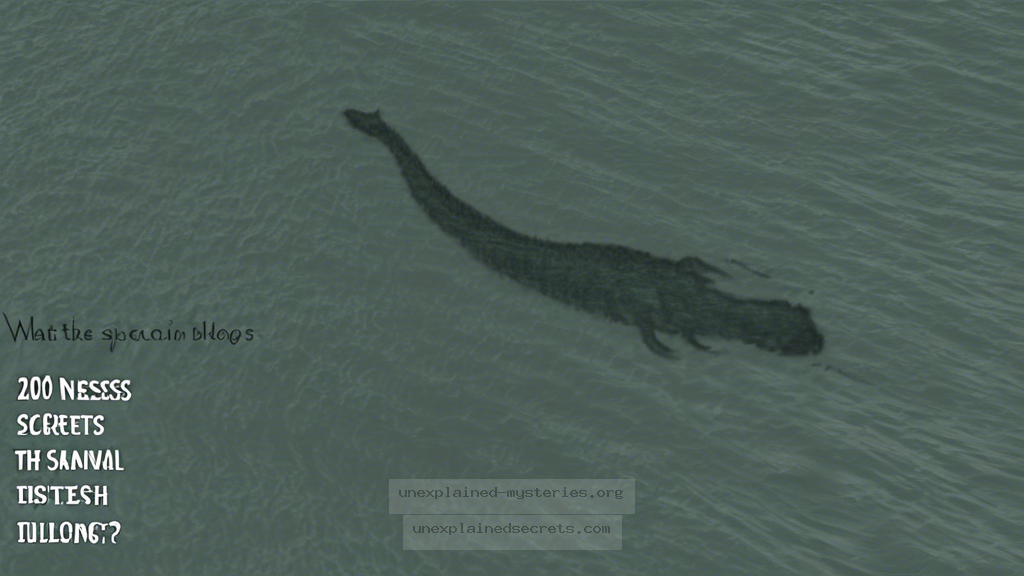What Secrets Does the 2005 Sonar Scan Reveal About the Loch Ness Monster?
What Secrets Does the 2005 Sonar Scan Reveal About the Loch Ness Monster?
The Loch Ness Monster, affectionately known as “Nessie,” has captivated the world for decades, drawing enthusiasts, scientists, and skeptics to Scotland’s Loch Ness. Among the many investigations into this elusive creature, a particular sonar scan conducted in 2005 has sparked intrigue and debate. What did this sonar scan uncover, and how does it contribute to our understanding of this enduring mystery? In this post, we’ll explore the details of the 2005 sonar scan, its findings, and the implications for ongoing Loch Ness research.
Historical Context: The Legend of Loch Ness
The legend of the Loch Ness Monster dates back to ancient times, with the first recorded sighting in 565 AD by St. Columba. Over the centuries, various accounts have emerged, ranging from vague descriptions to highly detailed encounters. The modern era of Nessie sightings began in the 1930s, coinciding with the construction of the A82 road, which increased public access to Loch Ness. The infamous 1934 “Surgeon’s Photograph” further fueled interest, although it was later revealed to be a hoax.
As the legend grew, so did the desire for scientific inquiry. The 2005 sonar scan was not the first attempt to verify Nessie’s existence; sonar technology had previously been employed in the search for the creature. However, the 2005 expedition was notable for its advanced equipment and methodologies, promising a rigorous approach to the Loch Ness mystery.
Core Concepts: Understanding Sonar Technology
Before delving into the findings of the 2005 sonar scan, it’s essential to understand how sonar technology works. Sonar, an acronym for Sound Navigation and Ranging, uses sound waves to detect and locate objects underwater. The technology emits sound pulses, which bounce off objects and return to the source. By analyzing the time it takes for the echoes to return, researchers can determine the distance and size of the underwater objects.
This technology has been crucial in marine exploration, allowing scientists to map the ocean floor and identify submerged structures. In the context of Loch Ness, sonar can help distinguish between natural formations, man-made objects, and potential living creatures. The 2005 scan, conducted by a team led by the Loch Ness Project, utilized advanced sonar equipment with high-resolution capabilities, making it one of the most comprehensive investigations conducted to date.
Practical Implications: The 2005 Sonar Scan Findings
During the 2005 sonar survey, the team scanned approximately 90 square miles of Loch Ness. The results were extraordinary: they recorded over 1,000 sonar contacts, including a large object that was estimated to be about 30 feet long. This discovery reignited discussions about the existence of the Loch Ness Monster, as the size of the object matched some eyewitness accounts of Nessie.
However, the findings were not without controversy. The sonar team noted that while they had detected a significant object, they could not confirm its identity. Various theories emerged, ranging from the possibility of a large fish, such as a sturgeon, to the presence of a large animal or even a submerged log. This ambiguity highlights the challenges of interpreting sonar data in complex environments like Loch Ness, which is known for its deep and murky waters.
Alternative Perspectives: Skeptics and Believers
The dichotomy between skeptics and believers in the Loch Ness Monster saga is well-documented. Skeptics argue that the evidence supporting Nessie’s existence is thin, often attributing sightings to misidentifications of common animals or natural phenomena. For example, the large object detected in the 2005 sonar scan could easily be a common fish or a submerged tree trunk, as opposed to an undiscovered creature.
On the other hand, believers argue that the sheer volume of sightings and anecdotal accounts over the years merits further investigation. They contend that many unexplained mysteries exist in nature, and the Loch Ness Monster could be one such case. Some enthusiasts even suggest that advanced technology, like Drones or ROVs (remotely operated vehicles), might yield better results in future expeditions.
Common Misconceptions: Debunking Myths About Nessie
One prevalent misconception surrounding the Loch Ness Monster is that it must be a dinosaur or prehistoric creature, such as a plesiosaur. While this theory is popularized in media and literature, it lacks scientific backing. The environmental conditions of Loch Ness are not conducive to supporting such large creatures, and the absence of fossil evidence further undermines this claim.
Another common myth is that Nessie has been conclusively proven to exist. The 2005 sonar scan and other investigations have provided tantalizing glimpses but no definitive proof. As such, the Loch Ness Monster remains a creature of legend, shrouded in mystery and intrigue.
Best Practices for Investigating Cryptids
For those interested in investigating cryptids like the Loch Ness Monster, there are several best practices to consider:
- Utilize scientific methods: Employ rigorous scientific techniques, including sonar, camera traps, and environmental DNA sampling.
- Document sightings carefully: Maintain detailed records of eyewitness accounts, including time, location, and descriptions of the sighting.
- Collaborate with experts: Engage with marine biologists, cryptozoologists, and historians to gain a well-rounded perspective on the investigation.
- Remain open-minded: While skepticism is healthy, it’s essential to remain open to new evidence and perspectives.
Future Developments: Ongoing Research and Technology
The 2005 sonar scan was just one chapter in the ongoing saga of Loch Ness research. Since then, advancements in technology have opened new avenues for exploration. For instance, the use of underwater drones equipped with high-definition cameras and sophisticated sensors promises to provide clearer insights into the depths of Loch Ness.
Additionally, environmental DNA (eDNA) analysis has emerged as a powerful tool for detecting life forms in aquatic environments. By analyzing water samples for traces of genetic material, researchers can identify the presence of various species without needing to capture them. This technique could provide valuable data about the biodiversity of Loch Ness and potentially reveal the existence of previously unknown creatures.
Conclusion: The Enduring Mystery of Loch Ness
The 2005 sonar scan of Loch Ness remains a pivotal moment in the quest to understand the Loch Ness Monster. While the scan provided intriguing evidence of a large underwater object, it also highlighted the complexities and ambiguities of investigating such mysteries. As technology continues to evolve, the potential for new discoveries grows, keeping the legend of Nessie alive and well.
Ultimately, the question of whether the Loch Ness Monster exists may never be definitively answered. Still, the combination of historical accounts, technological advancements, and ongoing research ensures that the intrigue surrounding Nessie will endure for generations to come.
Other Articles
Recent Posts
- What Happened to Flight MH370? The Conspiracy Theories That Still Haunt Us
- What Secrets Lurk Within the Walls of the Infamous Trans-Allegheny Lunatic Asylum?
- What Evidence Supports the Existence of Bigfoot in the Pacific Northwest?
- What Happened to the Indus Valley Civilization? Unraveling the Mysteries of Ancient Urban Life
- Can Telepathy Be Scientifically Proven Through Laboratory Evidence?







